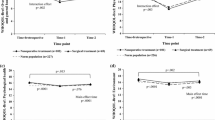Abstract
The purpose of this study was to compare ratings of motivation, satisfaction, self-efficacy, and cohesion between male and female soldiers undergoing basic training (BT) in a gender-integrated unit and to study whether the ratings differ in a subgroup of women who suffered stress fractures (SF) during the course of training. Data were collected from 3 different companies of an integrated combat unit using questionnaires that were completed by 41 male and 160 female soldiers (age 18.5 ± 0.4 years) at 3 phases during their BT (0, 2, and 4 months). In these questionnaires, the subjects were asked to evaluate their motivation, cohesion, satisfaction and self-efficacy. The presence or absence of bone overuse injuries was assessed by magnetic resonance imaging (MRI) or bone scintigraphy (BS). In addition to comparing parameters between females and males, female soldiers who sustained SF during BT (n = 18) were analyzed as a separate sub-group (FSF). In general, females in a gender-integrated combat unit were more motivated and satisfied with their service than their male counterparts. Overall, the stress fractures were associated with lower ratings of motivation, self-efficacy, and satisfaction expressed by the FSF sub-group.
Similar content being viewed by others
References
Armstrong DW 3rd, Rue JP, Wilckens JH, Frassica FJ (2004) Stress fracture injury in young military men and women. Bone 35:806–816
Bell NS, Mangione TW, Hemenway D, Amoroso PJ, Jones BH (2000) High injury rates among female army trainees: a function of gender? Am J Prev Med 18:141–146
Bem SL (1981) Gender schema theory: a cognitive account of sex typing. Psychol Rev 88:354–364
Brudvig TJ, Gudger TD, Obermeyer L (1983) Stress fractures in 295 trainees: a one-year study of incidence as related to age, sex, and race. Mil Med 148:666–667
Byrne DG (1996) Type A behavior, anxiety and neuroticism: reconceptualizing the pathophysiological paths and boundaries of coronary-prone behavior. Stress Med 12:227–238
Carver CS, Coleman AE, Glass DC (1976) The coronary-prone behavior pattern and the suppression of fatigue on a treadmill test. J Pers Soc Psychol 33:460–466
Draude TV (1995) Women in combat. Aviat Space Environ Med 66:1207–1211
Ekenman I, Tsai-Fellander L, Westblad P, Turan I, Rolf C (1996) A study of intrinsic factors in patients with stress fractures of the tibia. Foot Ankle Int 17:477–482
Ekenman I, Hassmen P, Koivula N, Rolf C, Fellander-Tsai L (2001) Stress fractures of the tibia: can personality traits help us detect the injury-prone athlete? Scand J Med Sci Sports 11:87–95
Fields KB, Delaney M, Hinkle JS (1990) A prospective study of type A behavior and running injuries. J Fam Pract 30:425–429
Hassmen P, Koivula N (1996) Ratings of perceived exertion by a group of women: does Type A behavior act a modifier? Percept Mot Skills 83:675–686
Hassmen P, Stahl R, Borg G (1993) Psychophysiological responses to exercise in type A/B men. Psychosom Med 55:178–184
Hod N, Ashkenazi I, Levi Y, Fire G, Drori M, Cohen I, Bernstine H, Horne T (2006) Characteristics of skeletal stress fractures in female military recruits of the Israel defense forces on bone scintigraphy. Clin Nucl Med 31:742–749
Jenkins CD, Zyzanski SJ, Rosenman RH (1971) Progress toward validation of a computer-scored test for the type A coronary-prone behavior pattern. Psychosom Med 33:193–202
Jones BH, Bovee MW, Harris JM 3rd, Cowan DN (1993) Intrinsic risk factors for exercise-related injuries among male and female army trainees. Am J Sports Med 21:705–710
Kjormo O, Halvari H (2002) Two ways related to performance in elite sport: the path of self-confidence and competitive anxiety and the path of group cohesion and group goal-clarity. Percept Mot Skills 94:950–966
Lappe J, Davies K, Recker R, Heaney R (2005) Quantitative ultrasound: use in screening for susceptibility to stress fractures in female army recruits. J Bone Miner Res 20:571–578
Milgrom C, Giladi M, Stein M, Kashtan H, Margulies JY, Chisin R, Steinberg R, Aharonson Z (1985) Stress fractures in military recruits. A prospective study showing an unusually high incidence. J Bone Joint Surg Br 67:732–735
Milgrom C, Finestone A, Shlamkovitch N, Giladi M, Lev B, Wiener M, Schaffler M (1995) Stress fracture treatment. Orthopaedics (Int Ed) 3:363–367
Ohman A, Burell G, Ramund B, Fleishman N (1992) Decomposing coronary-prone behaviou: dimensions of type A behavior in videotaped structured interview. J Psychopathol Behav Assess 14:21–54
Ostrow AC (1996) Directory of psychological tests in the sport and exercise sciences (2nd ed.). Fitness Information Technology Inc
Rolf C (1995) Overuse injuries of the lower extremity in runners. Scand J Med Sci Sports 5:181–190
Rosenman RH (1990) Type A behavior pattern: a personal overview. J Soc Behav Personality 5:1–24
Seibel MJ (2000) Molecular markers of bone turnover: biochemical, technical and analytical aspects. Osteoporos Int 11(Suppl 6):S18–29
UKMOD (2002) Women in the armed forces UK Ministry Of Defence
Van Mechelen W (1992) Running injuries. A review of the epidemiological literature. Sports Med 14:320–335
Acknowledgments
The authors would like to thank Mrs. Naomi Resnick and Mr. Orahn Preiss-Bloom for their support and contribution to this study.
Author information
Authors and Affiliations
Corresponding author
Rights and permissions
About this article
Cite this article
Hadid, A., Evans, R.K., Yanovich, R. et al. Motivation, cohesion, satisfaction, and their relation to stress fracture among female military recruits. Eur J Appl Physiol 104, 329–335 (2008). https://doi.org/10.1007/s00421-008-0717-7
Accepted:
Published:
Issue Date:
DOI: https://doi.org/10.1007/s00421-008-0717-7




